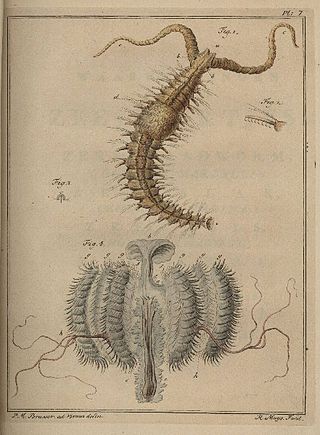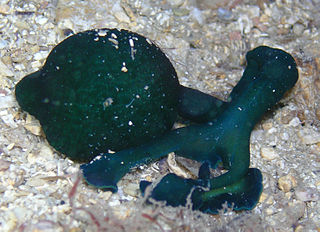
The Sipuncula or Sipunculida is a class containing about 162 species of unsegmented marine annelid worms. Sipuncula was once considered a phylum, but was demoted to a class of Annelida, based on recent molecular work.

The Echiura, or spoon worms, are a small group of marine animals. Once treated as a separate phylum, they are now considered to belong to Annelida. Annelids typically have their bodies divided into segments, but echiurans have secondarily lost their segmentation. The majority of echiurans live in burrows in soft sediment in shallow water, but some live in rock crevices or under boulders, and there are also deep sea forms. More than 230 species have been described. Spoon worms are cylindrical, soft-bodied animals usually possessing a non-retractable proboscis which can be rolled into a scoop-shape to feed. In some species the proboscis is ribbon-like, longer than the trunk and may have a forked tip. Spoon worms vary in size from less than a centimetre in length to more than a metre.

Ottoia is a stem-group archaeopriapulid worm known from Cambrian fossils. Although priapulid-like worms from various Cambrian deposits are often referred to Ottoia on spurious grounds, the only clear Ottoia macrofossils come from the Burgess Shale of British Columbia, which was deposited 508 million years ago. Microfossils extend the record of Ottoia throughout the Western Canada Sedimentary Basin, from the mid- to late- Cambrian. A few fossil finds are also known from China.

Urechis unicinctus, known as the fat innkeeper worm or penis fish, is a species of marine spoon worm in East Asia. It is also known as garloid colloquially. It is found in Bohai Gulf of China and off the Korean and Hokkaido coasts. It is not to be confused with a closely related species, Urechis caupo, which occurs on the western coast of North America and shares common names. The body is about 10–30 centimetres (3.9–11.8 in) long, cylindrical in shape and yellowish-brown in color. On the surface of the body there are many small papillae.
Phascolopsis gouldii is a species of unsegmented benthic marine worm, also known as a peanut worm or star worm. It lives in burrows in muddy sand in shallow waters off North America.

Lanice conchilega, commonly known as the sand mason worm, is a species of burrowing marine polychaete worm. It builds a characteristic tube which projects from the seabed, consisting of cemented sand grains and shell fragments with a fringe at the top.
Harrimania planktophilus is a marine acorn worm in the family Harrimaniidae. It lives in a burrow in sediment on the sea floor. It is only known from western Canada and was first described by Cameron in 2002. The species name is from the Greek and translates as "lover of plankton".
Listriolobus pelodes is a species of marine spoon worm. It is found in shallow seas in the North East Pacific off the coast of California. It lives in a burrow in soft sediments.
Prosphaerosyllis battiri is a species belonging to the phylum Annelida, a group known as the segmented worms. The species name comes from an Aboriginal word, battiri, meaning 'rough'. Prosphaerosyllis battiri is a species characterized by having only partially fused palps, an unretracted prostomium on its peristomium or showing only slight retraction, the shape of its dorsal cirri and its arrangement of papillae, being numerous anteriorly while less numerous posteriorly. It resembles Prosphaerosyllis semiverrucosa, but its arrangement of dorsal papillae is reversed.
Erinaceusyllis hartmannschroederae is a species belonging to the phylum Annelida, a group known as the segmented worms. This species was previously described in Australia as Sphaerosyllis erinaceus and S. erinaceus erinaceus, a species distributed throughout the globe. These species appear to be a species complex. Previous descriptions stated that the two aforementioned species possess compound chaetae blades which are long and slender. Several subspecies of S. erinaceus were described on the basis of differences in shapes and sizes of their compound chaetae; such differences are enough to consider them as distinct species. The species is named in honour of Gesa Hartmann-Schröder, an expert on syllid species.

Polydora ciliata is a species of annelid worm in the family Spionidae, commonly known as a bristleworm. It is a burrowing worm and is found in the northeastern Atlantic Ocean and some other parts of the world.
Saccoglossus bromophenolosus is a species of acorn worm occurring in the northwestern Atlantic Ocean and the northeastern Pacific Ocean. It grows to a length of about 20 cm (8 in) and lives in a burrow in soft sediment in the intertidal and subtidal zones. The scientific name refers to 2,4-dibromophenol, a secondary metabolite present in this worm.
Phascolosoma granulatum is a species of peanut worm in the family Phascolosomatidae. It is found in shallow water in the northeastern Atlantic Ocean and the Mediterranean Sea.

Bonelliidae is a family of marine worms noted for being sexually dimorphic, with males being tiny in comparison with the females. They occupy burrows in the seabed in many parts of the world's oceans, often at great depths.
Metabonellia is a genus of marine spoon worms in the family Bonelliidae. It is a monotypic genus and Metabonellia haswelli is the only species. It is commonly known as the green spoon worm and is found in shallow waters around Australia.

Urechis caupo is a species of spoon worm in the family Urechidae, commonly known as the innkeeper echiuran, the fat innkeeper worm, the innkeeper worm, or the penis fish. It is found in shallow water on the west coast of North America, between southern Oregon and Baja California, where it forms a U-shaped burrow in the sediment and feeds on plankton using a mucus net.

Ochetostoma erythrogrammon is a species of spoon worm in the family Thalassematidae. It is found in shallow water in the Atlantic Ocean, the Mediterranean Sea, and the Indian and Pacific Oceans, burrowing in soft sediment.

Sternaspis scutata is a species of marine polychaete worm in the family Sternaspidae. It occurs in the Mediterranean Sea and the temperate northeastern Atlantic Ocean. It lives submerged in mud or other soft sediment.
Maxmuelleria lankesteri is a species of spoon worm in the family Bonelliidae. It is found in the North Atlantic Ocean. It burrows into soft sediment on the seabed, mostly in deep water.

Phyllodoce lineata is a species of polychaete worm in the family Phyllodocidae. It is native to the northeastern Atlantic Ocean and the Mediterranean Sea where it occurs in the intertidal and shallow sub-tidal zones on soft sediment.











